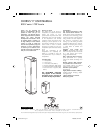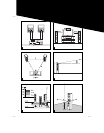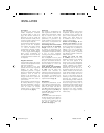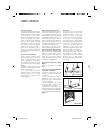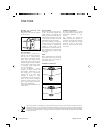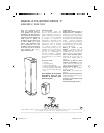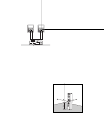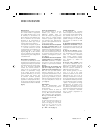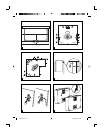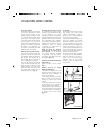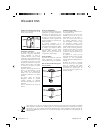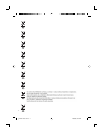INSTALLATION
Connections
The Chorus input sockets ensure
reliable multipurpose connections
for stripped cables as well as for
plugs. The “banana” terminals are
obstructed in order to comply with
electrical standards currently in force
in several countries. Make sure not to
remove the plastic safety lids.
It is imperative to respect the connector
polarity of both the loudspeaker
and amplifier. The positive terminal
“+” must be connected to the
corresponding (matching) amplifier’s
terminal and the negative terminal
“-“ to the negative terminal (fig. A).
Stereo image, soundstaging and
bass perception would be seriously
compromised if these conditions were
not respected.
Magnetic disturbance
In home theater systems, the magnetic
radiation of the loudspeakers must be
taken into consideration.
With the exception of the center
speakers which are fully magnetically
shielded, all other Chorus V
loudspeakers generate a magnetic
leak that can interfere with household
appliances, some of which are
sensitive to this phenomenon. It is
strongly advised not to place front
loudspeakers closer than 50cm to
your TV screen.
Frame geometry as well as colours can
be severely distorted by a magnetic
field if the loudspeaker is placed to
close to the TV. In case of problems,
some TV screens (or computer
monitor) feature a degauss control,
but not systematically (fig. B).
Positioning
The Chorus V loudspeakers have
been engineered to deliver the most
faithful sound reproduction, whether
they are used for music or home
cinema. In order to enhance their
performance, to guarantee a high
quality of listening, sound image and
tone balance, it is important to note
the following basic rules.
The listening area must be located
at the summit of an equilateral
triangle whose two other points
of insertion are determined by the
position of each speaker. Nevertheless
it is possible to modify these distances
to find an ideal compromise
according to the particular disposition
of the room (fig. C).
Each loudspeaker must be placed
at the same height and on the same
floor plan. The tweeter should be at
the same height as the listener’s ear,
when the listener is in their usual
listening area (fig. D).
Avoid placing the loudspeakers
too close to the room’s corners
or walls. This will induce some
unwanted room resonance and
artificially increase bass response. On
the contrary, if the bass level proves to
be insufficient, it is possible to move
the speakers closer to the walls to
adjust the bass level (fig. E).
Optimization
To please the perfectionists, we shall
give an optimum positioning formula :
if A is the distance from the boomer
centre to the closest wall (floor or
wall), B the intermediate distance and
C the longest distance (A<B<C), the
relation B
2
=AC determines the ideal
position of the speakers.
• Example 1:
The boomer centre is 60cm (24”) from
the floor (B=60cm) (mini speaker on
a foot), standing 50cm (20”) from
the back wall (A=50cm), the side
wall will be ideally 72cm (28”)
(C=B
2
⁄A=72cm) (fig. F).
User instructions
The sound rendition of the Chorus
loudspeaker depends strongly upon
the listening room’s acoustics, the
place of the loudspeakers and the
listening area. These factors can
be modified in order to correct or
enhance a desired effect.
Should the soundstage be im-
precise or not centred, try to move
the loudspeakers closer to each other.
Harsh or aggressive sound means that
your listening room is probably too
reflective. Try to use any absorbing
materials (such as tapestries, sofa,
wall coverings, curtains…) combined
with reflective materials to absorb or
diffuse resonances.
Should the sound be “flat”
or muffled, there are too many
absorbing materials in the listening
room. The sound appears to be
closed-in, with a narrow stereophonic
image. Try to find a better compromise
between absorbing and reflective
materials within your listening room.
Generally the wall to the rear of
the speakers should be made up of
reflective materials so that the sound
image exhibits satisfying volume and
width. On the contrary the wall on
the rear of the listener should be
absorbing in order to avoid reflections
damaging the perception of the
stereo soundstage. These reflections
may limit the impression of depth of
the sound image. Furniture, such as
bookshelves should be ideally placed
along the side walls in order to diffuse
sound waves and to prevent some
frequencies from being amplified,
especially in vocal range (it removes
“flutter echo”).
03
notice chorus v gb 3 26/09/06, 10:42:35



